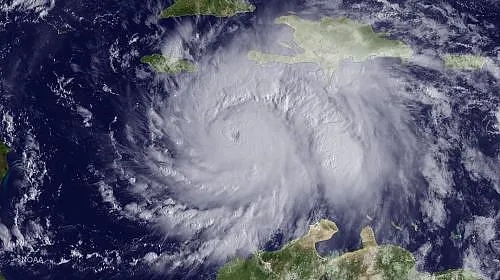PORT AU PRINCE—(Oct. 5, 2016) Hurricane Matthew crawled through Haiti on Tuesday, dumping massive amounts of rain, particularly in the southern peninsula, leaving thousands of Haitians in need of emergency assistance.
“The southern part of Haiti has been particularly heavy hit by Hurricane Matthew and is now cut off from the rest of the country,” said Jean-Michel Vigreux, CARE Country Director in Haiti. “We’re still assessing the impacts, but we know of floods, landslides and continuous heavy rains in some areas of the south. We also have heard of destroyed houses, streets and bridges, dead livestock and destroyed livelihoods.”
Vigreux compared the storm impact to that of Hurricanes Sandy or Hazel. CARE started distributing food and clean water to over 3,700 people in evacuation shelters in Port-au-Prince, the southeast and in Grande Anse Departments, where the brunt of the storm hit. And in the coming days CARE will be scaling up its response aiming to provide tarps and hygiene kits to some 50,000 people.
The storm hit the already vulnerable country where Haitians are still feeling the long-term effects of the 2010 earthquake, subsequent cholera outbreak, two cyclones, one tropical storm and two droughts.
“The population is very strained,” Vigreux said. “Strengthening people’s resilience will be key to any recovery plan.”
After leaving Haiti, Hurricane Matthew then hit eastern Cuba bringing strong winds, rain, landslides and coastal flooding. While the full extent of the impact remains unclear, early reports include damages to schools, buildings and houses, particularly in Guantanamo and Holguin provinces.
“Thanks to the Cuban government’s early efforts to evacuate residents, it’s expected there will be few casualties from this massive storm,” says Richard Paterson, CARE country representative in Cuba. “However, we are concerned about the long-term impact Matthew will have, especially in poor, rural areas for families whose homes, harvests and livelihoods may have been destroyed.”
CARE’s staff in the region report the needs here will likely focus on temporary shelter, clean water, food, education, and restoring livelihoods affected. Together with regional authorities and local partners, CARE’s team is assessing the situation and preparing to respond if required.
CARE has been working in Haiti since 1954, following the devastating Hurricane Hazel that left over 1,000 dead. After the deadly 2010 earthquake, CARE reached over 290,000 people with food, clean water, temporary shelter and other vital services. Along with responding to emergencies, CARE implements long-development programs such as education, food and livelihoods and women’s empowerment programs that build the resilience of vulnerable families.
Media Contact:
Nicole Harris, nharris@care.org, 404-735-0871
About CARE:
Founded in 1945, CARE is a leading humanitarian organization fighting global poverty. CARE has more than six decades of experience helping people prepare for disasters, providing lifesaving assistance when a crisis hits, and helping communities recover after the emergency has passed. CARE places special focus on women and children, who are often disproportionately affected by disasters. To learn more visit care.org.

